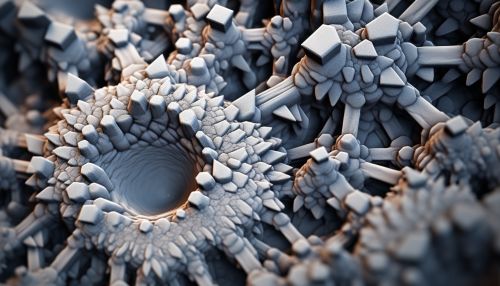Nuclear pore
Introduction
The nuclear pore is a complex structure that allows for the transport of molecules between the nucleus and the cytoplasm. It is an essential component of the nuclear envelope, the double lipid bilayer that surrounds the genetic material in eukaryotic cells.
Structure
The nuclear pore is a large protein complex composed of around 30 different proteins, known as nucleoporins. These proteins assemble into a structure that is approximately 120 nanometers in diameter. The structure of the nuclear pore is highly symmetrical, with an eight-fold rotational symmetry around the central axis.


Function
The primary function of the nuclear pore is to regulate the movement of molecules across the nuclear envelope. This includes the transport of proteins and RNA molecules into the nucleus, as well as the export of RNA and ribosomal subunits out of the nucleus. The nuclear pore achieves this through a selective barrier that allows for the passage of small molecules by passive diffusion, while larger molecules require active transport.
Transport Mechanism
The transport of molecules through the nuclear pore is a complex process that involves several steps. First, the molecule to be transported binds to a receptor protein in the cytoplasm. This receptor protein then interacts with the nucleoporins to facilitate the transport of the molecule through the pore. Once inside the nucleus, the molecule is released from the receptor protein, which is then recycled back to the cytoplasm.
Regulation
The nuclear pore complex plays a critical role in the regulation of gene expression. By controlling the transport of molecules into and out of the nucleus, the nuclear pore can influence the availability of transcription factors and other regulatory proteins, thereby affecting the rate of gene transcription.
Role in Disease
Mutations in the genes encoding nucleoporins can lead to a variety of diseases, including certain types of cancer and neurological disorders. For example, mutations in the gene for the nucleoporin NUP98 have been associated with acute myeloid leukemia.
